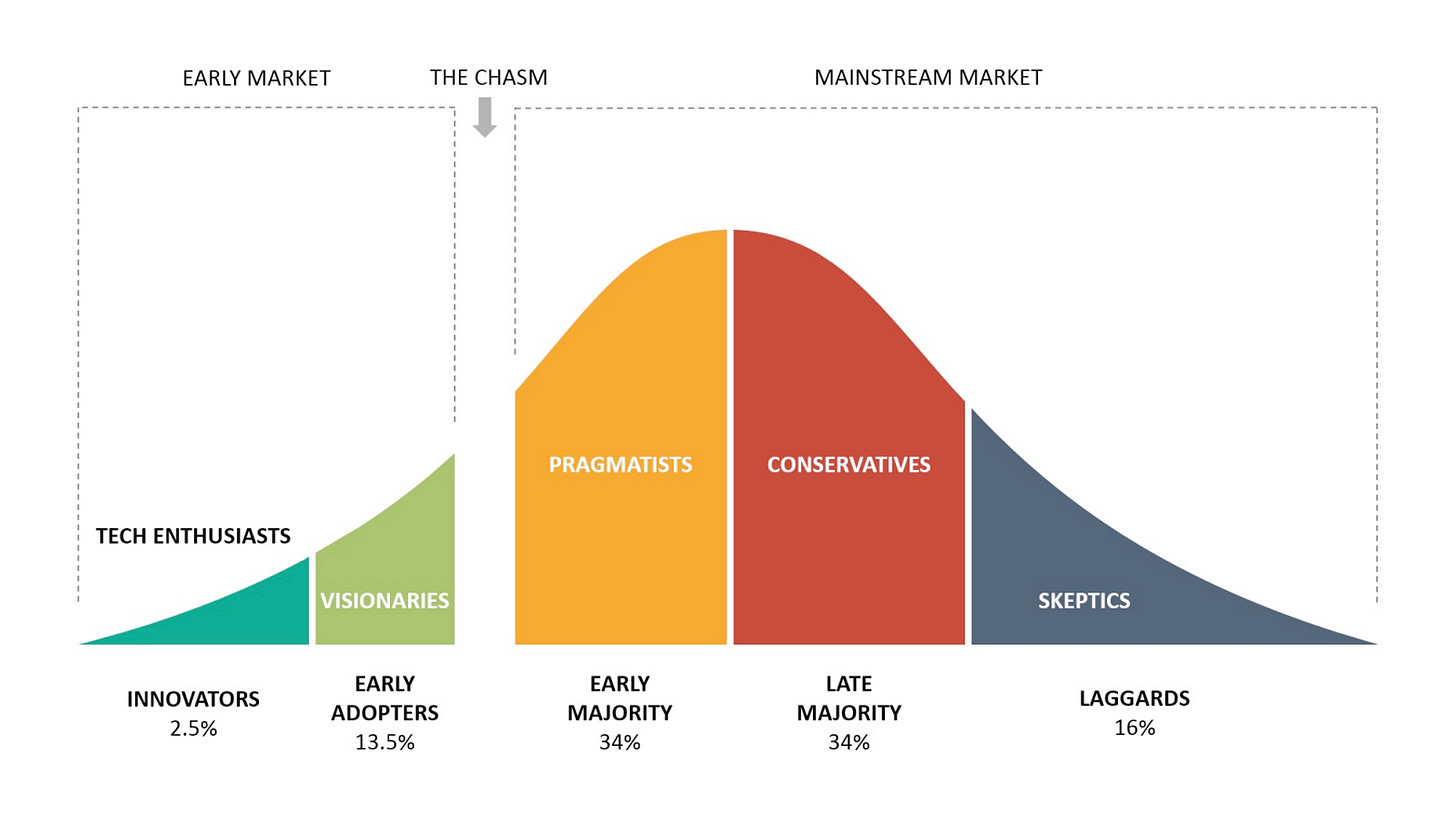The culprit: The Chasm model

Most of you have seen this model by now. Some people call it the early-adopter model, but in this piece, I call it the Chasm-model*.
In short, this model teaches some people are more likely than others to try out new technologies.
In his language: if you launch something novel, you are more likely to attract innovators and early adopters than laggards. Sounds logical.
By definition, startups try to create new products or services. Therefore, the argument goes, that startups should focus on innovators and early adopters as their launching customer base before going mainstream.
Open to innovation vs.
Open to your innovation
Duh. It’s like saying don’t sell tomatoes to people who don’t like veggies.
However, the real issue is not identifying people who are likely to try out new things.
The fact that some people are open to innovation doesn’t mean they are automatically interested in your solution.
Why should we assume that a person who always buys the latest iPhone will buy your expensive juice machine?
At best, (s)he is slightly more likely to buy your innovation. But that doesn’t help you in identifying your launching customer. And that is a problem.
Focus on problem urgency
To identify your launching customer, you need more than just willingness to try out new stuff.
You need to identify a customer’s ‘problem urgency’.
Problem urgency is the extent to which the problem is perceived to be problematic combined with the willingness to do something about it.
To give you some scaffolding, I created this model, containing 6 levels of problem urgency.
It includes levels such as “I don’t experience any problem” to “I NEED THIS SOLVED RIGHT NOW”. Get the gist?
Each level comes with the likelihood of a sale: the higher the urgency, the more likely you are to make a sale. Sounds logical, right?
Startups should always steer away from levels 1, 2 and 6. It’s just not going to work.
This leaves us with 3s, 4s and 5s: are they all ideal launching customers? No.
The Launching Customer Sweet Spot
The Chasm-model has something meaningful to say. The title above was just clickbait. The Chasm-model highlights attitudes towards novelty. Which we do actually need in identifying launching customers
If we combine the two viewpoints, we get something valuable: The launching customer sweet spot
The launching customer sweet spot is a combination of people who are open to new things and have high problem urgency.

Find your ideal launching customer
Your beachhead market should align with this launching customer sweet spot. How to achieve that?
For each problem interview you do, you should be able to put your person on this grid above.
You should try to find people in the sweet spot because these potential customers will be the easiest to work with. They are open to new things and want their problem fixed.
4s and 5s and innovators and early adopters only.
Few other archetypes on the grid might be okay to work with, but due to either a lack of true problem urgency or lack of openness to innovations, will cause more friction.
Latent problem owners need extra marketing to convince them, mainstreamers will be more picky about your solution. For launching customers, you don’t want that. Keep that for waves 2 and 3 of your go-to-market strategy.
I hope this clarifies things. Let me know in the comments and if you liked the article, share and like for extra exposure.
* The Chasm-model is not the official term. The Chasm is a (fictional) concept of why it is hard to enter the mainstream markets. Moore, the author of the book ‘Crossing the Chasm’, builds on the so-called innovation diffusion models of Rogers. Innovation diffusion models are quite common in scientific literature and often show either bell-curves or s-shaped curves to identify paces at which technologies are adopted by mass markets. /nerdmode🤓





Very well explained and to the point CHASM Model. I understood why i failed 5 times of small start up business
Loving this framework ✅